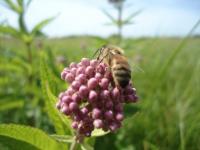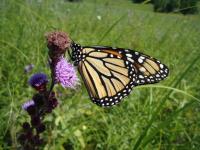Key Factors in Creating Quality Pollinator Habitat
With significant decline in pollinator populations like honey bees and native insects, creating quality habitat has never been more important. Whether enrolling in a program, such as CRP, or doing habitat projects on your own, keep pollinators in mind. Please consult with your local USDA Service Center for a more in-depth look at your site's specific pollinator strategy.
Pollinators come in all forms; including bees, butterflies, bats, birds, insects, and other animals. By creating habitat that is excellent for pollinator species, we are also:
- Increasing native plant populations
- Reducing soil erosion and improving water quality
- Creating aesthetics
- Providing food and habitat for other wildlife; pollinating insects are an important food source for wildlife, such as pheasant chicks
Plan for the Entire Growing Season
Diversity is key. Aim to have at least three species for each bloom period to provide continuous food sources for pollinators. Include plants with a variety of sizes and colors. Physical shape and size will attract different species of pollinators.
- Early season - April - June
- Mid season - June - August
- Late season - August - October
Location and Size
Avoid planting in areas that are subject to heavy chemical drift from neighboring fields. Planting in blocks rather than strips can help reduce the creation of chemical drift “traps”. If planted in strips, they should be at least 20 feet wide. Areas with pollinator habitat should be at least 0.5 acre in size.
Seed Mixes
To be most effective and beneficial, creating a seed mix with a high percentage of forbs is important.
Use Local Native Species
Select plants that are native to the region. They will be better adapted to the local soils and climate and can result in a more successful stand. Be sure to select species that are best suited for your site conditions (soil, hydrology, precipitation, elevation, drainage, aspect, sun/shade, and climate).
Do not plant non-native/invasive grasses and forbs. They can overtake native species, degrading the quality of the habitat. Always consult a biologist before planting to ensure the appropriate seed mix has been developed for your site.
Forbs
- CRP standard requires a minimum of nine species. Additional species are encouraged.
- Mix composition should be a minimum of 75% forbs based on seeds/ft2
Grasses
- Use at least two native bunch grasses in a mix. Try to avoid sod-forming grasses which may outcompete forbs.
- Seed mixes should be no more than 25% grass based on seeds/ft2




